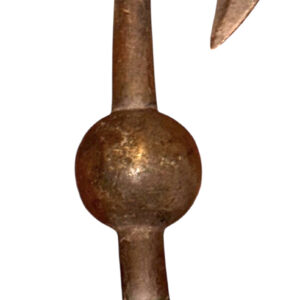ShopDecember 27, 2025
-

Doubly Id’d M1858 Civil War Enlisted Man’s Nine Button Infantry Frock Coat with Original Shoulder Scales – Pvt. Benjamin F. Clark Co. E 125th NY Infantry and Pvt. A. B. Clark Co. C 125th NY Infantry
$4,950Doubly Id’d M1858 Civil War Enlisted Man’s Nine Button Infantry Frock Coat with Original Shoulder Scales – Pvt. Benjamin F. Clark Co. E 125th NY Infantry and Pvt. A. B. Clark Co. C 125th NY InfantryDecember 27, 2025 -

US Model 1816 Flintlock .69 Cal. Musket Converted to the Maynard Tape Primer System by Remington in 1858
$1,750US Model 1816 Flintlock .69 Cal. Musket Converted to the Maynard Tape Primer System by Remington in 1858December 26, 2025 -

Possibly Unissued US Plates – “Baby” U.S. Cartridge Box Plate, Civil War Period U.S. Cartridge Box Plate and Eagle Breast Plate
Possibly Unissued US Plates – “Baby” U.S. Cartridge Box Plate, Civil War Period U.S. Cartridge Box Plate and Eagle Breast PlateDecember 23, 2025 -

Mid-19th Century Halberd Style Cast Brass Flagpole Finial
$650Mid-19th Century Halberd Style Cast Brass Flagpole FinialDecember 23, 2025 -

Original Civil War Period Box of Sharps Carbine and Rifle Cartridges Containing Three Remaining Sharps Linen Cartridges
$575Original Civil War Period Box of Sharps Carbine and Rifle Cartridges Containing Three Remaining Sharps Linen CartridgesDecember 19, 2025 -

Excavated Soldier Created Copper 5th Corps Badge– Dug at the Wilderness
$650Excavated Soldier Created Copper 5th Corps Badge– Dug at the WildernessDecember 18, 2025 -

Regimentally and Company Id’d Civil War Bone Cravat or Neckerchief Slide
$350Regimentally and Company Id’d Civil War Bone Cravat or Neckerchief SlideDecember 14, 2025 -

Civil War U.S. Regulation Navy Seaman’s Flat Hat
$1,500Civil War U.S. Regulation Navy Seaman’s Flat HatDecember 13, 2025 -

Late Civil War to Early Indian War Slouch Hat
$1,850Late Civil War to Early Indian War Slouch HatDecember 11, 2025 -

Id’d Carved Bone Cravat or Neckerchief Slide – Private David Zimmerman Co. E 129th Pa. Infantry – KIA at Chancellorsville
$575Id’d Carved Bone Cravat or Neckerchief Slide – Private David Zimmerman Co. E 129th Pa. Infantry – KIA at ChancellorsvilleDecember 10, 2025 -

Model 1840 Palmetto Armory Heavy Cavalry Saber
$3,500Model 1840 Palmetto Armory Heavy Cavalry SaberDecember 3, 2025 -

Excavated Confederate Clipped Corner Brass Belt Plate from Sailor’s Creek
Excavated Confederate Clipped Corner Brass Belt Plate from Sailor’s CreekNovember 23, 2025 -

Confederate Georgia Excavated Gutter Back Georgia Frame Belt Buckle
$575Confederate Georgia Excavated Gutter Back Georgia Frame Belt BuckleNovember 19, 2025 -

Confederate Georgia Excavated Georgia Frame Belt Buckle
$525Confederate Georgia Excavated Georgia Frame Belt BuckleNovember 18, 2025 -

Sea Trunk of Admiral Joseph Lanman Captain of the USS Minnesota during the Bombardment of Ft. Fisher
$1,950Sea Trunk of Admiral Joseph Lanman Captain of the USS Minnesota during the Bombardment of Ft. FisherNovember 18, 2025





